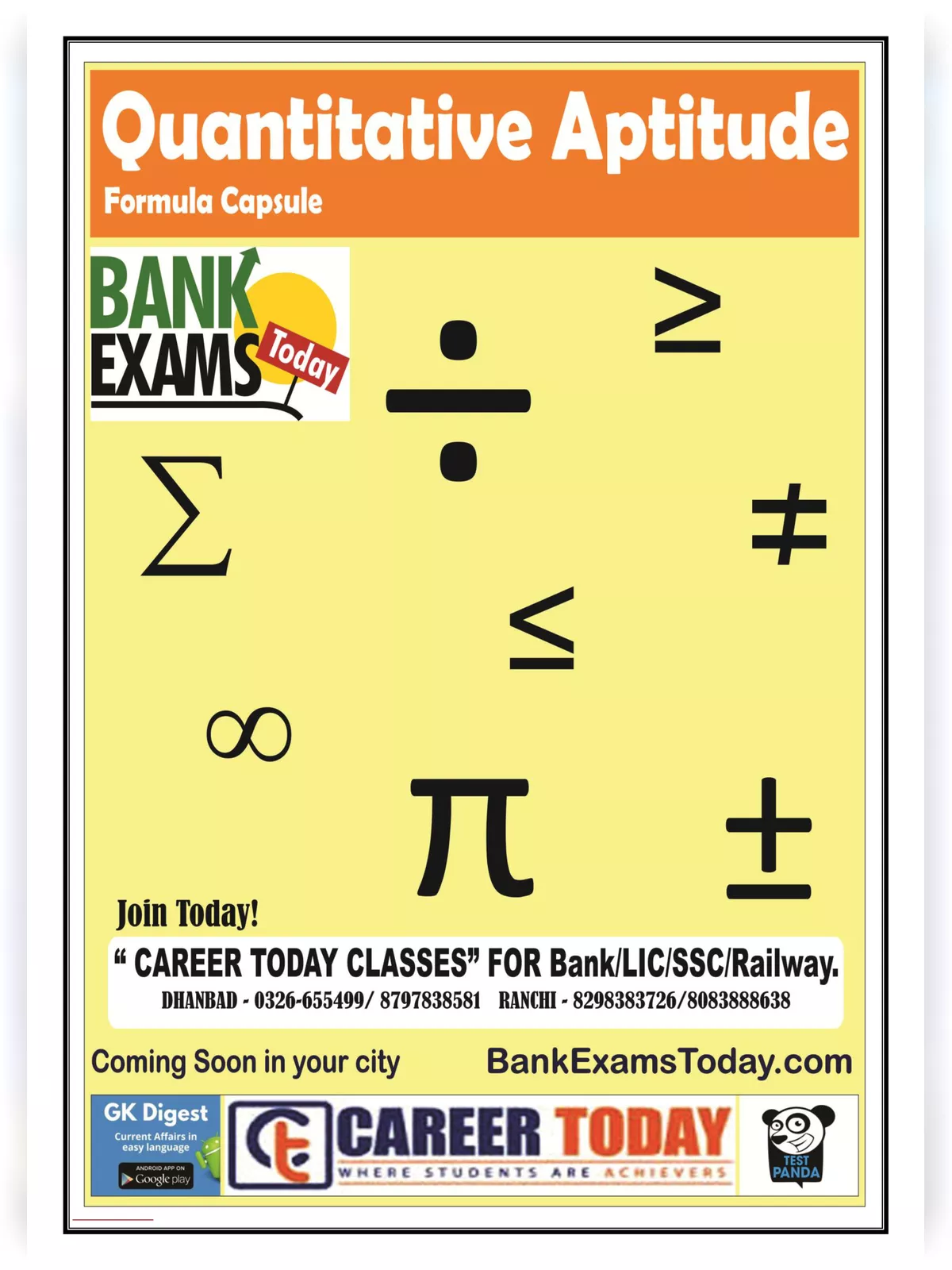CAT Quant Formulas - Summary
Competitive exams in India for MBA courses like CAT test a candidate’s skill on Quantitative Aptitude. The questions in the Quantitative Aptitude section are from various topics like Number Systems, Profit, Loss and Discount, LCM and HCF, Time and Work, Averages, Logarithm, Surds and Indices, Probability, Set Theory & Function, Trigonometry, Permutation & Combination, Co-ordinate Geometry, Mensuration, etc.
Here is a list of important formulae that candidates need to master to crack the Common Admission Test (CAT) successfully.
CAT Quant Formulas
Number Systems
- 1 + 2 + 3 + 4 + 5 + … + n = n(n + 1)/2
- (1² + 2² + 3² + ….. + n²) = n ( n + 1 ) (2n + 1) / 6
- (1³ + 2³ + 3³ + ….. + n³) = (n(n + 1)/ 2)²
- Sum of first n odd numbers = n²
- Sum of first n even numbers = n (n + 1)
Mathematical Formulas:
- (a – b)² = (a² + b² – 2ab)
- (a + b)² = (a² + b² + 2ab)
- (a + b)(a – b) = (a² – b²)
- (a + b)² = (a² + b² + 2ab)
- (a + b + c)² = a² + b² + c² + 2(ab + bc + ca)
- (a³ – b³) = (a – b)(a² + ab + b²)
- (a³ + b³) = (a + b)(a² – ab + b²)
- (a³ + b³ + c³ – 3abc) = (a + b + c)(a² + b² + c² – ab – bc – ac)
- When a + b + c = 0, then a³ + b³ + c³ = 3abc
- (a + b)n = an + (nC1)an-1b + (nC2)an-2b² + … + (nCn-1)abn-1 + bn
Profit, Loss, and Discount
- Profit/Gain = (S.P.) – (C.P.)
- Profit % = Profit/(C P)×100
- S P = (100+gain % )/100 ×C P
- C P = 100/(100+gain %)×S P
- Loss = (C.P.) – (S.P.)
- Loss % = Loss/(C.P.)×100
- S P = (100-loss %)/100×C P
- C P = 100/(100-loss %)×S P
LCM and HCF
LCM × HCF = Product of the Numbers
LCM of Co-prime Numbers = Product Of The Numbers
Speed, Time, and Distance
Distance = Speed x Time
Time = Distance/Speed
Speed= Distance/Time
Percentages
To find what percentage of x is y: y/x × 100
Increase N by S % = N( 1+ S/100 )
Decrease N by S % = N (1 – S/100)
Time and Work
If A can do a piece of work in n days, then A’s 1 day’s work = 1/n
If A’s 1 day’s work =1/n, then A can finish the work in n days.
Averages
Average = (Sum of observations/Number of observations)
Simple and Compound Interest

Logarithm

Probability
Sample Space: When we perform an experiment, then the set S of all possible outcomes is called the sample space.
Event: Any subset of a sample space is called an event.
The probability of Occurrence of an Event:
Let S be the sample and let E be an event.
Therefore, P(E) =n(E) / n(S)
Surds and Indices

Set Theory & Function
The Demorgan’s Law is the basic and most important formula for sets, which is defined as
(A ∩ B) ‘ = A’ U B’ and (A U B)’ = A’ ∩ B’
The relation R⊂A×AR⊂A×A is said to be called as:
- Reflexive Relation: If a R a ∀∀ a ∈∈ A.
- Symmetric Relation: If aRb, then bRa ∀∀ a, b ∈∈ A.
- Transitive Relation: If aRb, bRc, then aRc ∀∀ a, b, c ∈∈ A.
If any relation R is reflexive, symmetric and transitive in a given set A, then that relation is known as equivalence relation.
Permutation and Combination
Permutation Formula: A permutation is the choice of r things from a set of n things without replacement. Order matters in permutation.
![]()
Combination Formula: A combination is the choice of r things from a set of n things without replacement. Order does not matter in combination.
![]()
Mixtures and Allegations
Allegation: It is the rule that enables us to find the ratio in which two or more ingredients at the given price must be mixed to produce a mixture of desired price.
Mean Price: The cost of a unit quantity of the mixture is called the mean price.
Rule of Alligation:
If two ingredients are mixed, then
(Quantity of cheaper / Quantity of dearer) = (C.P. of dearer – Mean Price / Mean price – C.P. of cheaper)
Trigonometry
Trigonometric Identities:
- Sine=Opposite/Hypotenuse
- Secant=Hypotenuse/Adjacent
- Cosine=Adjacent/Hypotenuse
- Tangent=Opposite/Adjacent
- Co−Secant=Hypotenuse/Opposite
- Co−Tangent=Adjacent/Opposite
The reciprocal identities are given as:
- CosecΘ=1/sinΘ
- secΘ=1/cosΘ
- cotΘ=1/tanΘ
- sinΘ=1/CosecΘ
- cosΘ=1/secΘ
- tanΘ=1/cotΘ
Coordinate Geometry
The Distance Between two Points A and B:
AB² = (Bx – Ax)² + (By – Ay)²
The Midpoint of a Line Joining Two Points
The midpoint of the line joining the points (x1, y1) and (x2, y2) is:
[½(x1 + x2), ½(y1 + y2)]
The Equation of a Line Using One Point and the Gradient
The equation of a line which has gradient m and which passes through the point (x1, y1) is:
y – y1 = m(x – x1)
Mensuration
Rectangle
Area = lb
Perimeter = 2(l+b)
Square
Area = a×a
Perimeter = 4a
Triangle
Area =b×h/2 or √s(s-a)(s-b)(s-c)…………….where s=a+b+c/2
Circle
Area = πr² or πd²/4
Circumference = 2πr or πd
Area of sector of a circle = (θπr² )/360
Cube
Volume: V = l3
Lateral surface area = 4a2
Surface Area: S = 6s2
Diagonal (d) = √3l
Cuboid
Volume of cuboid: lbh
Total surface area = 2 (lb + bh + hl) or 6l2
Length of diagonal =√(l²+b²+h²)
